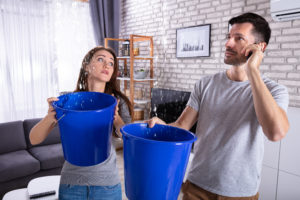While most people are understandably concerned about insuring their homes against fire loss, that risk is not what causes the most losses for homeowners.
Water damage is a more common threat that accounts for more claims than fire damage. Statistics show that one out of every five homes will experience some kind of water damage each year. In fact, only wind and hail damage occurs more frequently.
A little bit of water can cause a lot of damage. Two inches of water in a 2,500 square foot one-story home can cause almost $27,000 in damage.
 The problem is more than just the monetary cost; water damage losses can disrupt your life for long stretches of time. A Texas woman lost the use of her downstairs for months after a household pet chewed a hole in a soft water line.
The problem is more than just the monetary cost; water damage losses can disrupt your life for long stretches of time. A Texas woman lost the use of her downstairs for months after a household pet chewed a hole in a soft water line.
Water can escape from leaky hoses or connections that have worn out or were improperly made in the first place. It can drip out of damaged or corroded pipes. It can reverse course because of clogged drains or toilets.
Rain can enter through holes in a roof or through an open or damaged window. Water can seep in when a stream overflows its banks, a heavy snowfall melts or during an intense summer downpour.
Fortunately, homeowners can take a few simple steps to prevent their downstairs from becoming ponds:
- Know where your water shutoff valves are. If water is running from your plumbing system to your floor, minimize the damage by stopping the flow in its tracks. Shutoff valves are under sinks, against bathroom walls and in basements.
- Check appliance hoses and faucets for leaks. The hoses connected to washing machines and dishwashers could be faulty.
- Look for cracks and loose connections in pipes. Get them repaired immediately.
- Check showers and tubs for worn-out caulking. Reseal as necessary.
- Install a water leak detection system. Some insurance companies offer discounts on homeowner’s insurance premiums for them.
What to do if you have water damage
If you do suffer water damage, insurance may pay for some losses but not others.
While all homeowner’s insurance policies differ from each other somewhat, they typically cover damage from water that escapes from pipes in ceilings, floors and walls.
They will also cover damage from water that enters through the roof (though not the repairs to the roof, unless it was also damaged accidentally), or through a window broken during a storm.
Some companies offer coverage for an additional premium that will pay for damage when a toilet or some other drain backs up.
It is important to know that virtually no policies will cover damage caused by floods, tidal waves, melting snow, heavy rainfall, or ground water seeping into the house.
Some of these losses may be covered by flood insurance, available either directly from the federal government or from an insurance company selling it on their behalf.
Water can cause enormous damage to your home and cause incredible inconvenience. Prevent these accidents if you can ― and have the right insurance protection.










